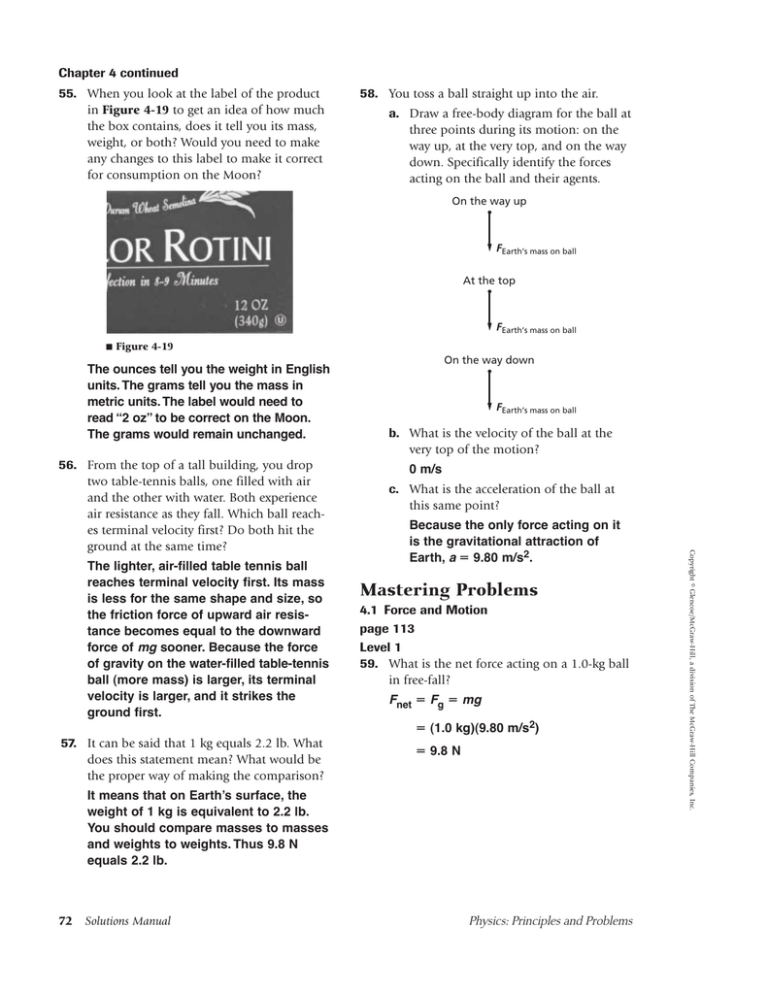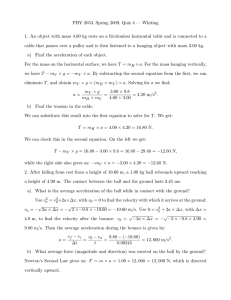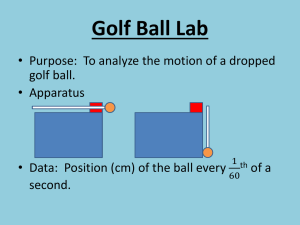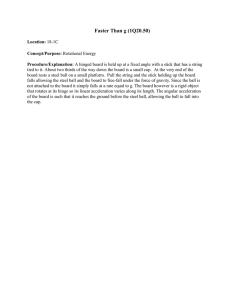Mastering Problems
advertisement

Chapter 4 continued 55. When you look at the label of the product in Figure 4-19 to get an idea of how much the box contains, does it tell you its mass, weight, or both? Would you need to make any changes to this label to make it correct for consumption on the Moon? 58. You toss a ball straight up into the air. a. Draw a free-body diagram for the ball at three points during its motion: on the way up, at the very top, and on the way down. Specifically identify the forces acting on the ball and their agents. On the way up FEarth’s mass on ball At the top FEarth’s mass on ball ■ Figure 4-19 The ounces tell you the weight in English units. The grams tell you the mass in metric units. The label would need to read “2 oz” to be correct on the Moon. The grams would remain unchanged. The lighter, air-filled table tennis ball reaches terminal velocity first. Its mass is less for the same shape and size, so the friction force of upward air resistance becomes equal to the downward force of mg sooner. Because the force of gravity on the water-filled table-tennis ball (more mass) is larger, its terminal velocity is larger, and it strikes the ground first. FEarth’s mass on ball b. What is the velocity of the ball at the very top of the motion? 0 m/s c. What is the acceleration of the ball at this same point? Because the only force acting on it is the gravitational attraction of Earth, a ! 9.80 m/s2. Mastering Problems 4.1 Force and Motion page 113 Level 1 59. What is the net force acting on a 1.0-kg ball in free-fall? Fnet ! Fg ! mg ! (1.0 kg)(9.80 m/s2) 57. It can be said that 1 kg equals 2.2 lb. What does this statement mean? What would be the proper way of making the comparison? ! 9.8 N It means that on Earth’s surface, the weight of 1 kg is equivalent to 2.2 lb. You should compare masses to masses and weights to weights. Thus 9.8 N equals 2.2 lb. 72 Solutions Manual Physics: Principles and Problems Copyright © Glencoe/McGraw-Hill, a division of The McGraw-Hill Companies, Inc. 56. From the top of a tall building, you drop two table-tennis balls, one filled with air and the other with water. Both experience air resistance as they fall. Which ball reaches terminal velocity first? Do both hit the ground at the same time? On the way down Chapter 4 continued 60. Skating Joyce and Efua are skating. Joyce pushes Efua, whose mass is 40.0-kg, with a force of 5.0 N. What is Efua’s resulting acceleration? F ! ma F a! ! m 65. Three objects are dropped simultaneously from the top of a tall building: a shot put, an air-filled balloon, and a basketball. a. Rank the objects in the order in which they will reach terminal velocity, from first to last. balloon, basketball, shot put b. Rank the objects according to the order in which they will reach the ground, from first to last. 5.0 N ! ! 40.0 kg ! 0.12 m/s2 shot put, basketball, balloon 61. A car of mass 2300 kg slows down at a rate of 3.0 m/s2 when approaching a stop sign. What is the magnitude of the net force causing it to slow down? F ! ma ! (2300 kg)(3.0 m/s2) ! 6.9"103 N Copyright © Glencoe/McGraw-Hill, a division of The McGraw-Hill Companies, Inc. 62. Breaking the Wishbone After Thanksgiving, Kevin and Gamal use the turkey’s wishbone to make a wish. If Kevin pulls on it with a force 0.17 N larger than the force Gamal pulls with in the opposite direction, and the wishbone has a mass of 13 g, what is the wishbone’s initial acceleration? F a! ! 0.17 N ! !! 0.013 kg ! 13 m/s2 4.2 Using Newton’s Laws pages 113–114 Level 1 63. What is your weight in newtons? Fg ! mg ! (9.80 m/s2)(m) Answers will vary. 64. Motorcycle Your new motorcycle weighs 2450 N. What is its mass in kilograms? Fg ! mg 2450 N 9.80 m/s m ! ! ! !! 2 g They are inverses of each other. 66. What is the weight in pounds of a 100.0-N wooden shipping case? (100.0 N)! ! "! ! " ! 22 lb 1 kg 9.80 N 2.2 lb 1 kg 67. You place a 7.50-kg television on a spring scale. If the scale reads 78.4 N, what is the acceleration due to gravity at that location? Fg ! mg Fg g! ! m 78.4 N ! ! 7.50 kg m Fg c. What is the relationship between your answers to parts a and b? ! 2.50"102 N Physics: Principles and Problems ! 10.5 m/s2 Level 2 68. Drag Racing A 873-kg (1930-lb) dragster, starting from rest, attains a speed of 26.3 m/s (58.9 mph) in 0.59 s. a. Find the average acceleration of the dragster during this time interval. !v a! ! !t (26.3 m/s # 0.0 m/s) ! !!! 0.59 s ! 45 m/s2 b. What is the magnitude of the average net force on the dragster during this time? F ! ma ! (873 kg)(45 m/s2) ! 3.9"104 N Solutions Manual 73 Chapter 4 continued c. Assume that the driver has a mass of 68 kg. What horizontal force does the seat exert on the driver? F ! ma ! (68 kg)(45 m/s2) e. It slows to a stop while moving downward with a constant acceleration. Depends on the magnitude of the acceleration. Fscale ! Fg $ Fslowing ! 3.1"103 N ! mg $ ma 69. Assume that a scale is in an elevator on Earth. What force would the scale exert on a 53-kg person standing on it during the following situations? a. The elevator moves up at a constant speed. Fscale ! Fg ! mg ! m(g $ a) ! (53 kg)(9.80 m/s2 $ a) 70. A grocery sack can withstand a maximum of 230 N before it rips. Will a bag holding 15 kg of groceries that is lifted from the checkout counter at an acceleration of 7.0 m/s2 hold? ! (53 kg)(9.80 m/s2) Use Newton’s second law Fnet ! ma. ! 5.2"102 N If Fgroceries % 230, then the bag rips. b. It slows at 2.0 m/s2 while moving upward. Fgroceries ! mgroceriesagroceries $ mgroceriesg Slows while moving up or speeds up while moving down, ! mgroceries(agroceries $ g) Fscale ! Fg $ Fslowing ! (15 kg)(7.0 m/s2 $ 9.80 m/s2) ! mg $ ma ! 250 N The bag does not hold. ! m(g $ a) ! 4.1"102 N c. It speeds up at 2.0 m/s2 while moving downward. Slows while moving up or speeds up while moving down, Fscale ! Fg $ Fspeeding ! mg $ ma ! (53 kg)(9.80 m/s2 # 2.0 m/s2) ! 4.1"102 N d. It moves downward at a constant speed. Fscale ! Fg ! mg 74 Solutions Manual ! mg ! (0.50 kg)(9.80 m/s2) ! 4.9 N Level 3 72. Astronomy On the surface of Mercury, the gravitational acceleration is 0.38 times its value on Earth. a. What would a 6.0-kg mass weigh on Mercury? Fg ! mg(0.38) ! (53 kg)(9.80 ! Flift ! Fg It would move at a constant speed. ! m(g $ a) 5.2"102 71. A 0.50-kg guinea pig is lifted up from the ground. What is the smallest force needed to lift it? Describe its resulting motion. N m/s2) ! (6.0 kg)(9.80 m/s2)(0.38) ! 22 N Physics: Principles and Problems Copyright © Glencoe/McGraw-Hill, a division of The McGraw-Hill Companies, Inc. ! (53 kg)(9.80 m/s2 # 2.0 m/s2)



